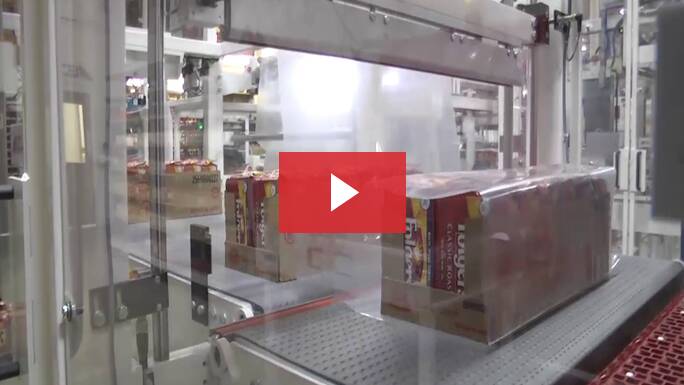21 August 2015 //
There are many different types of packaging machines that can bundle and shrink-wrap, and understanding which one will best fit your products is important. Two of the most common types of secondary packaging machines are inline automatic systems and continuous motion systems. While both have many similarities (inline format, type of enclosures, and film consumption), understanding the differences between the two systems is important to ensure that you select the one that will have your production line running smoothly and efficiently.
The following explains the differences between inline automatic and continuous motion systems and outlines production conditions in which you would want to use one versus the other.
Inline Automatic
The way an inline automatic system operates is by running product down a feed conveyor and then transferring it to a pacing conveyor. The purpose of the pacing conveyor is to achieve proper spacing between products, causing the conveyor to start and stop in order to control the product’s speed. This is because the additional product is being wrapped downstream.
Next, the product is transferred off the pacing conveyor, through the web of film, across the continuous band sealer gap, and onto the sealer exit conveyor. Once the product crosses the gap, the sealer exit conveyor stops and the seal jaw closes, creating a total wrap enclosure around the product. After the seal is made, the jaw opens and the sealer exit conveyor starts back up, transferring the product to the shrink tunnel belt, which completes one cycle. The wrapping process then repeats for the next product.
When to consider an inline automatic system:
- Your product is consistent. Products that are similar in size, shape, and weight benefit most from an inline automatic system because the conveyors and the speeds can be designed to meet exact production needs.
- Your product is stable. The product has sufficient mass to navigate through the sealer without additional assistance.
- Your production speeds are slower. When running an inline automatic you will likely have time to get the product off the sealer exit conveyor and into the shrink tunnel before bringing another product in. You will also have time for the conveyors to be stopped during the sealing cycle.
- You require a system with a small footprint. By nature, the inline automatic system is shorter in length than a continuous motion system where the seal jaw movement needs to reciprocate, which requires an additional conveyor length and space to accommodate the seal jaw movement’s sealing time (e.g., a 2-second sealing time and a conveyor belt speed of 45 feet per minute would require 18 inches of travel distance).
Continuous Motion
Continuous motion systems operate by running the product down the conveyor and transferring it to the sealer infeed conveyor. The sealer infeed and exit conveyors reciprocate along with the seal jaw movement. As the product gets to the end of the sealer infeed conveyor and starts onto the sealer exit conveyor, the seal jaw reciprocates toward and over the product. When the product is fully on the sealer exit conveyor, the seal jaw starts to close, and the conveyors begin reciprocating back along the product-travel direction. Once the seal is complete, the next product is ready to be transferred off the sealer infeed conveyor and onto the sealer exit conveyor, starting the process all over again. The key difference in a continuous motion system is that the product never stops moving forward, unlike in an inline automatic system where the product may need to stop twice.
When to consider a continuous motion system:
- Your product has varying lengths. Since the product does not stop, you only need to have a slight gap between products larger than the seal jaw.
- Your production speeds are faster. Since the conveyors are continuously running, there is no worry that a product will become stuck halfway between the tunnel conveyor and the sealer exit conveyor. This also means that the conveyor will not be stopped during the sealing cycle.
- Your product is lighter in weight. Products that are too light may not transfer across the jaw opening and through the web of film on an inline automatic system. On a continuous motion machine, the motion of the reciprocating seal jaw pulls the film out and drapes it over the next product. This way the product does not have to pull the film as it moves across the jaw opening.
As you can see, there are unique differences between inline automatic and continuous motion packaging systems. If you require an inline format packaging system, don’t hesitate to reach out to a packaging expert who can help determine which one fits your product best. Ready to talk to someone now? Contact EDL Packaging today.

